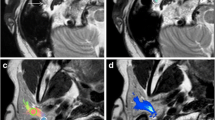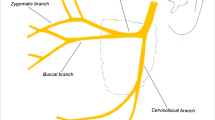Abstract
Objectives
To assess the feasibility of intraparotid facial nerve (VIIn) tractographic reconstructions in estimating the presence of a contact between the VIIn and the tumour, in patients requiring surgical resection of parotid tumours.
Methods
Patients underwent MR scans with VIIn tractography calculated with the constrained spherical deconvolution model. The parameters of the diffusion sequence were: b-value of 1000 s/mm2; 32 directions; voxel size: 2 mm isotropic; scan time: 9’31’. The potential contacts between VIIn branches and tumours were estimated with different initial fractional anisotropy (iFA) cut-offs compared to surgical data. Surgeons were blinded to the tractography reconstructions and identified both nerves and contact with tumours using nerve stimulation and reference photographs.
Results
Twenty-six patients were included in this study and the mean patient age was 55.2 years. Surgical direct assessment of VIIn allowed identifying 0.1 as the iFA threshold with the best sensitivity to detect tumour contact. In all patients with successful VIIn identification by tractography, surgeons confirmed nerve courses as well as lesion location in parotid glands. Mean VIIn branch FA values were significantly lower in cases with tumour contact (t-test; p ≤ 0.01).
Conclusions
This study showed the feasibility of intraparotid VIIn tractography to identify nerve contact with parotid tumours.
Key points
• Diffusion imaging is an efficient method for highlighting the intraparotid VIIn.
• Visualization of the VIIn may help to better manage patients before surgery.
• We bring new insights to future trials for patients with VIIn dysfunction.
• We aimed to provide radio-anatomical references for further studies.





Similar content being viewed by others
Abbreviations
- VIIn:
-
Facial nerve
- CF:
-
Cervicofacial branch
- TF:
-
Temporofacial branch
- DTI:
-
Diffusion tensor imaging
- CSD:
-
Constrained spherical deconvolution
- FA:
-
Fractional anisotropy
- bFFE:
-
Balanced fast field echo
- ROI:
-
Region of interest
- FND:
-
Facial nerve division
- ODF:
-
Orientation density function
- SNR:
-
Signal to noise ratio
- SH:
-
Spherical harmonic
- IAC:
-
Internal auditory canal
- DW:
-
Diffusion-weighted imaging
References
Guntinas-Lichius O, Klussmann JP, Wittekindt C, Stennert E (2006) Parotidectomy for benign parotid disease at a university teaching hospital: outcome of 963 operations. Laryngoscope 116:534–540
Gaillard C, Périé S, Susini B, St Guily JL (2005) Facial nerve dysfunction after parotidectomy: the role of local factors. Laryngoscope 115:287–291
Qin Y, Zhang J, Li P, Wang Y (2011) 3D double-echo steady-state with water excitation MR imaging of the intraparotid facial nerve at 1.5T: a pilot study. AJNR Am J Neuroradiol 32:1167–1172
Li C, Li Y, Zhang D et al (2012) 3D-FIESTA MRI at 3 T demonstrating branches of the intraparotid facial nerve, parotid ducts and relation with benign parotid tumours. Clin Radiol 67:1078–1082
Farquharson S, Tournier J-D, Calamante F et al (2013) White matter fiber tractography: why we need to move beyond DTI. J Neurosurg 118:1367–1377
Tournier J-D, Calamante F, Gadian DG, Connelly A (2004) Direct estimation of the fiber orientation density function from diffusion-weighted MRI data using spherical deconvolution. Neuroimage 23:1176–1185
Tournier J-D, Calamante F, Connelly A (2007) Robust determination of the fibre orientation distribution in diffusion MRI: non-negativity constrained super-resolved spherical deconvolution. Neuroimage 35:1459–1472
Calamante F, Oh S-H, Tournier J-D et al (2013) Super-resolution track-density imaging of thalamic substructures: comparison with high-resolution anatomical magnetic resonance imaging at 7.0T. Hum Brain Mapp 34:2538–2548
Calamante F, Tournier J-D, Kurniawan ND et al (2012) Super-resolution track-density imaging studies of mouse brain: comparison to histology. Neuroimage 59:286–296
Tournier J-D, Yeh C-H, Calamante F et al (2008) Resolving crossing fibres using constrained spherical deconvolution: validation using diffusion-weighted imaging phantom data. Neuroimage 42:617–625
Landis JR, Koch GG (1977) The measurement of observer agreement for categorical data. Biometrics 33:159–174
Kwak HH, Park HD, Youn KH et al (2004) Branching patterns of the facial nerve and its communication with the auriculotemporal nerve. Surg Radiol Anat 26:494–500
Davis RA, Anson BJ, Budinger JM, Kurth LR (1956) Surgical anatomy of the facial nerve and parotid gland based upon a study of 350 cervicofacial halves. Surg Gynecol Obstet 102:385–412
Salame K, Ouaknine GER, Arensburg B, Rochkind S (2002) Microsurgical anatomy of the facial nerve trunk. Clin Anat 15:93–99
Roundy N, Delashaw JB, Cetas JS (2012) Preoperative identification of the facial nerve in patients with large cerebellopontine angle tumors using high-density diffusion tensor imaging. J Neurosurg 116:697–702
Taoka T, Hirabayashi H, Nakagawa H et al (2006) Displacement of the facial nerve course by vestibular schwannoma: preoperative visualization using diffusion tensor tractography. J Magn Reson Imaging 24:1005–1010
Righini CA, Petrossi J, Reyt E, Atallah I (2014) An original submandibular approach technique sparing the cervical branch of the facial nerve. Eur Ann Otorhinolaryngol Head Neck Dis 131:143–146
Conturo TE, Lori NF, Cull TS et al (1999) Tracking neuronal fiber pathways in the living human brain. Proc Natl Acad Sci U S A 96:10422–10427
Descoteaux M, Deriche R, Knösche TR, Anwander A (2009) Deterministic and probabilistic tractography based on complex fibre orientation distributions. IEEE Trans Med Imaging 28:269–286
Jones DK (2004) The effect of gradient sampling schemes on measures derived from diffusion tensor MRI: a Monte Carlo study. Magn Reson Med 51:807–815
Hodaie M, Chen DQ, Quan J, Laperriere N (2012) Tractography delineates microstructural changes in the trigeminal nerve after focal radiosurgery for trigeminal neuralgia. PLoS ONE 7:e32745
Budzik J-F, Balbi V, Verclytte S et al (2014) Diffusion tensor imaging in musculoskeletal disorders. Radiographics 34:E56–E72
Rotshenker S (2011) Wallerian degeneration: the innate-immune response to traumatic nerve injury. J Neuroinflammation 8:109
Khalil C, Hancart C, Le Thuc V et al (2008) Diffusion tensor imaging and tractography of the median nerve in carpal tunnel syndrome: preliminary results. Eur Radiol 18:2283–2291
Barcelo C, Faruch M, Lapègue F et al (2013) 3-T MRI with diffusion tensor imaging and tractography of the median nerve. Eur Radiol 23:3124–3130
Guggenberger R, Markovic D, Eppenberger P et al (2012) Assessment of median nerve with MR neurography by using diffusion-tensor imaging: normative and pathologic diffusion values. Radiology 265:194–203
Breitenseher JB, Kranz G, Hold A et al (2015) MR neurography of ulnar nerve entrapment at the cubital tunnel: a diffusion tensor imaging study. Eur Radiol 25:1911–1918
Jengojan S, Kovar F, Breitenseher J et al (2015) Acute radial nerve entrapment at the spiral groove: detection by DTI-based neurography. Eur Radiol 25:1678–1683
Tournier J-D, Calamante F, Connelly A (2013) Determination of the appropriate b value and number of gradient directions for high-angular-resolution diffusion-weighted imaging. NMR Biomed 26:1775–1786
Pannek K, Mathias JL, Bigler ED et al (2011) The average pathlength map: a diffusion MRI tractography-derived index for studying brain pathology. Neuroimage 55:133–141
Willats L, Raffelt D, Smith RE et al (2014) Quantification of track-weighted imaging (TWI): characterisation of within-subject reproducibility and between-subject variability. Neuroimage 87:18–31
Chang H-C, Juan C-J, Chiu H-C et al (2014) Effects of gender, age, and body mass index on fat contents and apparent diffusion coefficients in healthy parotid glands: an MRI evaluation. Eur Radiol 24:2069–2076
Smith RE, Tournier J-D, Calamante F, Connelly A (2015) The effects of SIFT on the reproducibility and biological accuracy of the structural connectome. Neuroimage 104:253–265
Smith RE, Tournier J-D, Calamante F, Connelly A (2013) SIFT: spherical-deconvolution informed filtering of tractograms. Neuroimage 67:298–312
Acknowledgments
We acknowledge the valuable assistance of Patrice Jousse (Neuroradiology – Grenoble) for editing artwork and Matthieu Roustit (Clinical Research Center – Inserm CIC1406) for helping with statistics. This work was presented at the European Congress of Radiology (ECR) in 2014. The scientific guarantor of this publication is Arnaud Attyé. The authors of this manuscript declare no relationships with any companies, whose products or services may be related to the subject matter of the article.
The authors state that this work has not received any funding. One of the authors has significant statistical expertise. Institutional review board approval was obtained. Written informed consent was waived by the institutional review board. Methodology: prospective, diagnostic study, performed at one institution.
Author information
Authors and Affiliations
Corresponding author
Rights and permissions
About this article
Cite this article
Attyé, A., Karkas, A., Troprès, I. et al. Parotid gland tumours: MR tractography to assess contact with the facial nerve. Eur Radiol 26, 2233–2241 (2016). https://doi.org/10.1007/s00330-015-4049-9
Received:
Revised:
Accepted:
Published:
Issue Date:
DOI: https://doi.org/10.1007/s00330-015-4049-9




